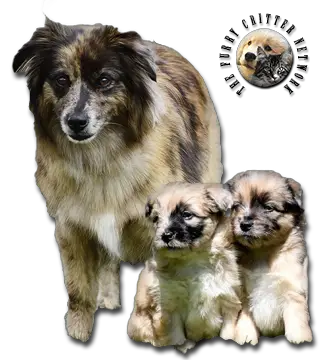Breed Standard
Head: Wedge-shaped, like that of the brown bear. Stop not accentuated. Long-haired variety has a fairly short muzzle. Smooth-muzzled variety has a longer muzzle.
Ears: Short, generally cropped. Carried three-fourths erect with tips breaking forward or to the side.
Eyes: Dark brown color. Black rims. Walleyes are permitted in dogs with harlequin or slate-gray coat.
Body: The body of the smooth-muzzled variety is slightly shorter than that of the long-haired variety. Strong neck. Deep, broad chest. Long back. Oblique croup.
Tail: Long-haired variety: not too long, full fringe, attached low and forming a hook at the tip; often docked. Smooth-muzzled variety: Fairly long, thick hair forming a flag, carried low; hook at the tip; tail circles over the back making a wheel when dog is alerted.
Hair: Long-haired variety: long- or medium-length, thick, almost flat or slightly wavy; more wooly on the croup and thighs; hair on muzzle and cheeks falls backward. Texture between wool and goat hair. Smooth-muzzled variety: thick, flat, fairly long and flexible; longer on the tail and around the neck; head covered with short, fine hair; short hair on legs and culottes on the thighs.
Coat: Long-haired variety: dark fawn with or without a mixture of black hairs, occasionally with white spots on the chest and feet; light gray with white on the head, chest, and legs; shades of harlequin. White coat is a disqualification. Smooth-muzzled variety: white or white with gray (badger), pale yellow, wolf gray, or tan spots on the head, ears, and base of the tail. Badger coat preferred.
Size: Long-haired variety - Dog: 40 to 48 cm; Bitch: 38 to 46 cm.Smooth-muzzled variety - Dog: 40 to 54 cm; Bitch: 40 to 52 cm.
Weight: Both varieties: 8 to 15 kg.
History
The history of the smallest French sheepdog traces back many years. It is thought that he descended from local breeds and never left the high valleys of the Pyrenees mountains until the late 19th century. During WW I, the Pyrenean Shepherd Dog was used as a lookout and messenger dog and to search for wounded. The breed was standardized in 1936. This breed was called by various names, which reflected its region of origin, such as the Berger de Pyrenees, the Landes Shepherd, the Bagn res Shepherd, the Auzun Shepherd, the Arbazzi Shepherd, etc. The Berger de Pyrenees, the largest and most rustic looking, measuring 50 to 55 cm at the withers, was almost recognized as a separate breed in 1935. Today, the Berger de Pyrenees no longer exists; it is considered a Pyrenean Shepherd Dog. There are two varieties of this breed, the very common long-haired variety and the rarer smooth-muzzled variety, which has short hair on the head and has a shorter body than the long-haired variety. After the first World War, the Pyrenean Shepherd gained national recognition in France for their valiant work as couriers, search and rescue dogs, watch dogs, and company mascots.
The smooth-faced Pyrenean Shepherd in its harlequin or blue merle coloration may have been one of the foundation breeds for the Australian Shepherd when sheep herders brought their sheepdogs to the American West when they flew to the United States as contract herders for the Western Range Association in the 1940s until the early 1970s.
It is not yet a well-known breed outside of its native France, but its size, intelligence, and attractive coat make it appealing. After one of its breed won the World Agility Championship for midsized dogs in 2003, it gained more attention as an intelligent performance dog for dog sports.
Behavior
The smooth-muzzled Pyrenean Shepherd Dog is a less nervous, more trainable dog than the long-haired variety. Hyperactive, energetic, and having an excessively nervous disposition, this dog needs constant exercise. This is not an easy breed. This courageous dog is rather vocal, is wary of anything unknown, and is constantly on guard. He needs a strong-minded owner.
This dog is not suited to apartment-living. If left alone, he will destroy everything within reach. If not given enough exercise, he will become aggressive. Weekly brushing is adequate.
Function
Sheepdog, Guard Dog, Pet, Utility Dog: search-and-rescue (in wreckage), drug and explosives dog.
Health
All adult dogs should be evaluated for hip dysplasia and eye problems, though. Elbows and hearing may also be checked.






